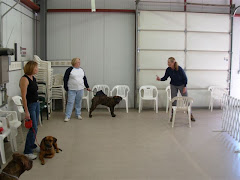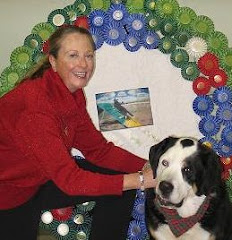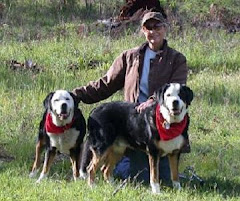
"That dog's gonna go live somewhere else pretty soon, I think," my neighbor Pete muttered, motioning over his shoulder at the big white dog barking her head off in the goat pen behind us. "Anything will start her barking, even when it's just a deer going by at 2:30 a.m. Now I have to keep her chained up in the pen, or she'll dig out. And if she gets loose, she'll tear up any dog that comes around. I can't have that liability."
Pete's a rancher. He knows the value of true working dogs, and has known Great Pyrenees who have really earned their keep. But Polly, his current Pyr in the goat pen, is a "pain in the rear," according to Pete.
The Great Pyrenees is a beautiful, huge dog with long white hair and big brown eyes. To the uneducated, she appears to be a white Newfoundland. But this giant dog is far different from the laid-back Newfy, who is content to lie around the house when she's not out doing water rescues.
A Pyr is specifically bred to guard sheep and goats in a pasture against wild predators at night, when the rest of the world is sleeping. That means she's nocturnal; she is happy working a night shift with minimal or no supervision. It's said that she is predominantly white and woolly so she will blend in with the flock she's protecting.
Over the years I've worked with several dozen Pyrs, most of whom were bought to be companion dogs and house pets. Some of the people bought them because they fell in love with the Pyr's striking appearance and usually gentle, demure character. Some were show breeders. Others were people who wanted this huge, fluffy dog as a status ornament because their friends had one.
All of them would agree that the Pyr has two major behavior problems: barking and wandering. Not surprising when you consider the job they were bred to do...roaming a pasture alone at night, and barking a "stay away" signal to any would-be predators. They'll also tell you that the Pyr is willful (i.e. stubborn) and won't do something she doesn't want to do (like obedience commands). Or, if she does it, she'll do it when SHE wants to, or she'll do it begrudgingly. These dogs do not possess a high "will to please," like a Golden Retriever or Lab. This is because her genetic job description does not include working side by side with man! Again, she works the nightshift, by herself.
Most Great Pyrenees owners I've worked with understand this. They want basic obedience instruction for their dogs and do not aspire to enter competitions with them. They find that the dogs are extremely loyal, and usually submissive, to their humans. They are not as agreeable around other animals, including dogs. They don't look to start fights, but they may get snarly if a strange dog gets too pushy. They tend to be moody, aloof, manipulating with their big brown eyes, slow to react to commands, and very intelligent. If a Pyr decides she doesn't want to do a sit-stay, she won't do it; she'll lie down instead!
There are many families who have Pyrs as house dogs, despite the huge amount of hair and grooming, and the dog's problematic behaviors. It's hard not to fall in love with a soft, fluffy dog with such adorable eyes. People like Vic and Joan Ruiz, who breed champion show Pyrs up on Chinook Pass, know how to balance their dogs' will to work with their will to win in the show ring. Vic and Joan also work with their dogs in obedience, and have helped several of their Pyrs earn Canine Good Citizen (CGC) awards. But they'll be the first to tell you that owning a Pyr is a lot of work, that the breed is not for everybody, and that it is NOT a dog for city-dwellers.
My neighbor Pete's dog, Polly, is probably bored silly. She barks to entertain herself. Chances are, if she were not penned up with the goats, she would bark much less and be a happier dog. She wouldn't be trying to dig out of the pen, and she wouldn't be as aggressive to dogs because she'd be too busy "working." My advice to Pete is that he re-home Polly on a big sheep ranch where Polly can do what she's bred to do: work the nightshift, riding herd by herself on a band of sheep in a huge pasture.
Pete's a rancher. He knows the value of true working dogs, and has known Great Pyrenees who have really earned their keep. But Polly, his current Pyr in the goat pen, is a "pain in the rear," according to Pete.
The Great Pyrenees is a beautiful, huge dog with long white hair and big brown eyes. To the uneducated, she appears to be a white Newfoundland. But this giant dog is far different from the laid-back Newfy, who is content to lie around the house when she's not out doing water rescues.
A Pyr is specifically bred to guard sheep and goats in a pasture against wild predators at night, when the rest of the world is sleeping. That means she's nocturnal; she is happy working a night shift with minimal or no supervision. It's said that she is predominantly white and woolly so she will blend in with the flock she's protecting.
Over the years I've worked with several dozen Pyrs, most of whom were bought to be companion dogs and house pets. Some of the people bought them because they fell in love with the Pyr's striking appearance and usually gentle, demure character. Some were show breeders. Others were people who wanted this huge, fluffy dog as a status ornament because their friends had one.
All of them would agree that the Pyr has two major behavior problems: barking and wandering. Not surprising when you consider the job they were bred to do...roaming a pasture alone at night, and barking a "stay away" signal to any would-be predators. They'll also tell you that the Pyr is willful (i.e. stubborn) and won't do something she doesn't want to do (like obedience commands). Or, if she does it, she'll do it when SHE wants to, or she'll do it begrudgingly. These dogs do not possess a high "will to please," like a Golden Retriever or Lab. This is because her genetic job description does not include working side by side with man! Again, she works the nightshift, by herself.
Most Great Pyrenees owners I've worked with understand this. They want basic obedience instruction for their dogs and do not aspire to enter competitions with them. They find that the dogs are extremely loyal, and usually submissive, to their humans. They are not as agreeable around other animals, including dogs. They don't look to start fights, but they may get snarly if a strange dog gets too pushy. They tend to be moody, aloof, manipulating with their big brown eyes, slow to react to commands, and very intelligent. If a Pyr decides she doesn't want to do a sit-stay, she won't do it; she'll lie down instead!
There are many families who have Pyrs as house dogs, despite the huge amount of hair and grooming, and the dog's problematic behaviors. It's hard not to fall in love with a soft, fluffy dog with such adorable eyes. People like Vic and Joan Ruiz, who breed champion show Pyrs up on Chinook Pass, know how to balance their dogs' will to work with their will to win in the show ring. Vic and Joan also work with their dogs in obedience, and have helped several of their Pyrs earn Canine Good Citizen (CGC) awards. But they'll be the first to tell you that owning a Pyr is a lot of work, that the breed is not for everybody, and that it is NOT a dog for city-dwellers.
My neighbor Pete's dog, Polly, is probably bored silly. She barks to entertain herself. Chances are, if she were not penned up with the goats, she would bark much less and be a happier dog. She wouldn't be trying to dig out of the pen, and she wouldn't be as aggressive to dogs because she'd be too busy "working." My advice to Pete is that he re-home Polly on a big sheep ranch where Polly can do what she's bred to do: work the nightshift, riding herd by herself on a band of sheep in a huge pasture.


















No comments:
Post a Comment